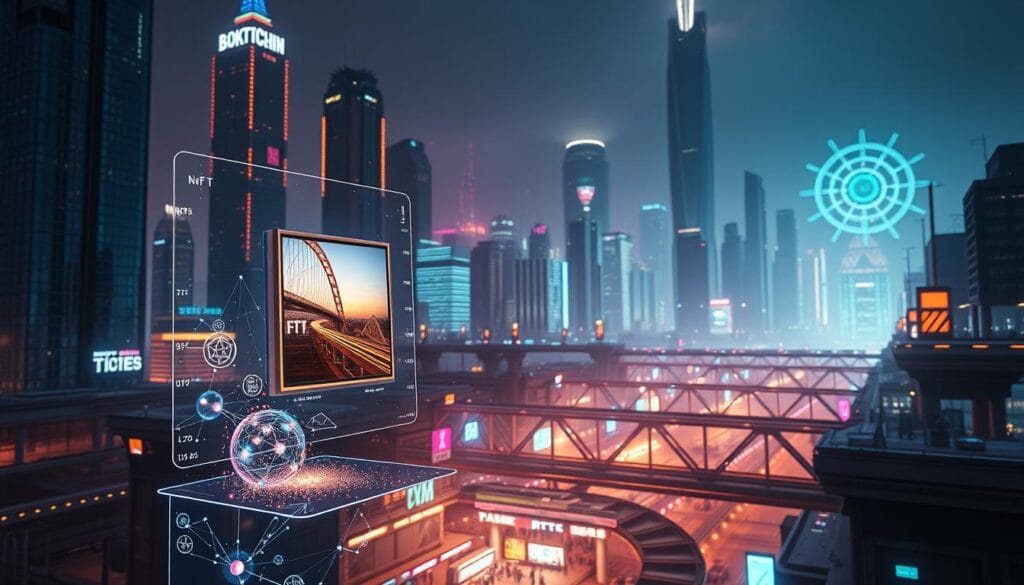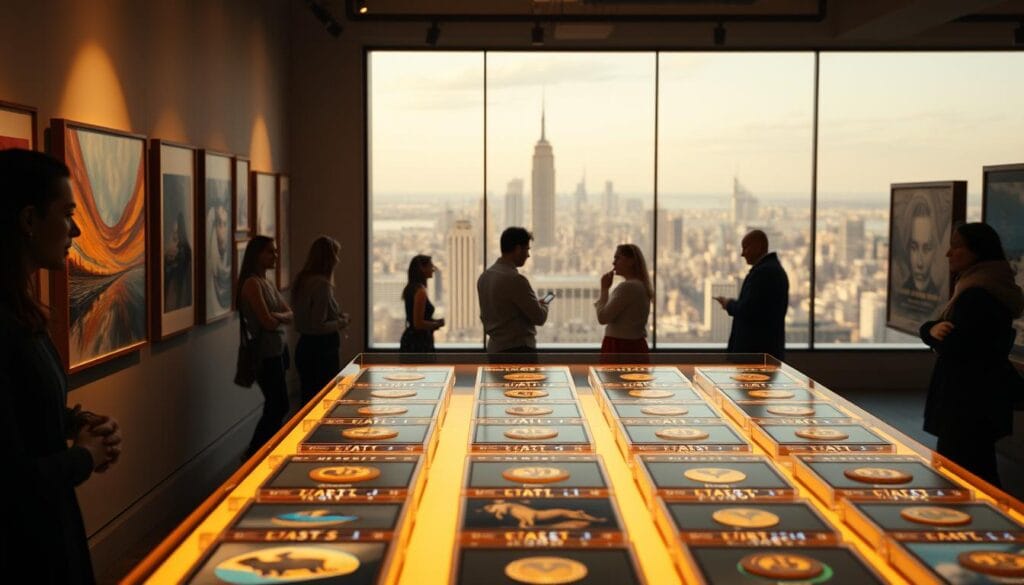Did you know that over $2 billion in fine art is now accessible to everyday investors through digital tokens? This seismic shift, driven by blockchain technology, is dismantling barriers that once reserved high-value masterpieces for elite collectors. By converting physical artworks into divisible digital assets, markets once deemed exclusive are opening to global participation.
Traditional ownership models are being redefined through fractional ownership, allowing multiple investors to hold shares in a single piece. Platforms leveraging decentralized ledgers ensure transparency, enabling real-time tracking of provenance and transaction histories. This innovation not only reduces fraud risks but also creates liquidity for historically illiquid assets.
Iconic works, from Warhol prints to Renaissance sculptures, now exist as tokens traded on secure digital marketplaces. Artists similarly benefit, retaining royalties through smart contracts embedded in their creations. As decentralized financial solutions expand—such as those explored in decentralized lending platforms—the fusion of creativity and technology unlocks unprecedented opportunities.
Key Takeaways
- Blockchain ensures transparent and secure tracking of art ownership and transactions.
- Fractional models democratize access to high-value pieces for diverse investors.
- Digital tokens transform illiquid physical assets into tradable commodities.
- Artists gain recurring revenue streams via programmable royalty agreements.
- Global markets are expanding as regulatory frameworks adapt to digital ownership.
Introduction to the Future of Art Investment

The fusion of blockchain and creative markets is rewriting the rules of asset ownership. By digitizing physical works into tradable shares, tokenization injects liquidity into a sector long dominated by exclusivity. This shift democratizes access while establishing verifiable ownership trails through decentralized ledgers.
Overview of Tokenization in Creative Assets
Tokenization divides an artwork’s value into digital tokens, each representing partial stakes. Secured on blockchain networks, these tokens enable transparent tracking of provenance and sales history. Unlike traditional models, this system lets multiple investors collectively own high-value pieces, transforming them into liquid assets.
Why 2025 is a Pivotal Year
Regulatory frameworks in key markets like the U.S. are nearing maturity, reducing legal ambiguities for digital asset trading. Concurrently, smart contract advancements streamline royalty payouts and automate compliance checks. As platforms standardize token issuance protocols, institutional participation is anticipated to surge, stabilizing markets and broadening accessibility.
Understanding Tokenized Art Investments 2025

Digital innovation is reshaping how high-value collectibles transition from physical objects to tradeable assets. By converting paintings or sculptures into blockchain-based tokens, ownership structures evolve beyond traditional boundaries. This shift introduces fractional participation, enabling broader access while maintaining rigorous provenance tracking.
Defining Tokenization and Fractional Ownership
Tokenization involves dividing a physical artwork’s value into digital shares, each representing partial ownership. Platforms like Ethereum use smart contracts to mint these tokens, ensuring compliance with predefined rules. Fractional models allow multiple investors to collectively own a masterpiece, reducing individual capital requirements from millions to hundreds of dollars.
The Role of Blockchain Technology
Decentralized ledgers provide immutable records of transactions and provenance. Every transfer or sale is timestamped and visible to network participants, minimizing fraud risks. For example, Tezos’ energy-efficient blockchain supports tokenized assets with lower environmental impact than proof-of-work systems. Such technology also enables automated royalty distributions, ensuring creators receive payments instantly when secondary sales occur.
The global market for these digital shares is projected to grow as regulatory clarity improves. Analysts note platforms like OpenSea and SuperRare now host thousands of tokenized pieces, from contemporary works to historical artifacts. This expansion reflects rising demand for alternative assets that combine cultural value with liquidity.
The Evolution of the Art Market and Digital Transformation

The art market’s transition from gallery walls to digital wallets marks one of the most significant economic shifts of the decade. Auction houses now compete with blockchain-powered platforms where cryptographic tokens represent ownership stakes. This evolution addresses longstanding issues like opacity in pricing and limited access for international buyers.
From Traditional to Digital Art
For centuries, physical galleries and live auctions dominated creative markets. Today, decentralized ledgers enable instant global transactions. Christie’s 2023 partnership with a blockchain registry illustrates this shift, allowing buyers to verify provenance through immutable records.
Tokenization reshapes how collectors engage with pieces. A single Picasso painting can now exist as 10,000 digital shares, each tradable across borders. This model attracts younger demographics seeking fractional assets rather than full acquisitions.
Shifts in Market Demand and Valuation
Traditional appraisal methods relied on expert committees and historical comparisons. Dynamic valuation algorithms now analyze real-time data like social media engagement and secondary sales patterns. Artory’s blockchain registry, for instance, tracks price fluctuations across 40+ platforms.
Enhanced transparency fuels confidence in digital markets. Collectors no longer depend on intermediaries to authenticate works—smart contracts autonomously verify origins. As accessibility grows, emerging artists gain opportunities to bypass gatekeepers and connect directly with global audiences.
Investment Opportunities in Art Tokenization

Democratizing access to high-value creative works, blockchain-driven markets now enable investors to acquire fractional stakes in multimillion-dollar masterpieces. This process eliminates traditional barriers, such as prohibitive pricing and geographic restrictions, by converting physical pieces into divisible digital shares.
New Avenues for Retail and Institutional Investors
Platforms like Masterworks allow retail participants to invest as little as $500 in blue-chip paintings, mirroring strategies used in real estate fractionalization. Institutional players, meanwhile, leverage blockchain’s transparency to build diversified portfolios of tokenized assets. A 2024 Sotheby’s report noted a 210% year-over-year increase in secondary market transaction volume for fractional shares.
Enhanced Liquidity and Global Market Access
By transforming historically illiquid works into tradable tokens, blockchain platforms enable 24/7 global trading. For example, a Basquiat painting tokenized on Ethereum saw 87% faster resale cycles compared to traditional auctions. This liquidity mirrors advantages seen in real estate markets but with lower entry costs.
As highlighted in recent analyses, digital ownership models let investors balance portfolios with uncorrelated assets. One platform’s users reduced portfolio volatility by 18% through strategic allocations to tokenized Renaissance works alongside conventional holdings.
Fractional Ownership and Portfolio Diversification

Investors seeking to mitigate risk increasingly turn to fractional models, where high-value assets are divided into tradable shares. This approach transforms inaccessible markets—like fine art—into opportunities for balanced portfolio construction. By holding digital stakes across multiple pieces, individuals reduce exposure to single-asset volatility while accessing historically elite markets.
Benefits of Diversifying with Tokenized Assets
Tokenization enables investors to allocate funds across diverse commodities, from paintings to real estate, without large capital commitments. A 2024 Artory report found portfolios containing tokenized creative works showed 23% less volatility during stock market downturns. These digital tokens act as uncorrelated hedges, performing independently of traditional equities.
Smart contracts automate critical processes, such as royalty distributions and authenticity verification. For example, a Basquiat painting split into 5,000 tokens on Ethereum automatically shares resale profits among stakeholders. This contrasts with conventional markets, where intermediaries delay payments and charge hefty fees.
Modern platforms also simplify cross-asset trading. Investors might pair Renaissance-era shares with effective cryptocurrency trading strategies, creating layered risk buffers. As regulatory frameworks mature, fractional models are poised to redefine wealth-building paradigms beyond physical estate or precious metals.
Blockchain Platforms Empowering Tokenized Art

Blockchain networks are revolutionizing how creators and collectors engage with high-value works through decentralized solutions. Leading platforms like Ethereum, Tezos, Polygon, and Solana offer distinct frameworks for managing digital assets, balancing security, efficiency, and creative rights protection.
Exploring Ethereum and Smart Contracts
Ethereum remains the cornerstone for tokenization due to its robust smart contract ecosystem. These self-executing agreements automate ownership transfers and royalty distributions, reducing reliance on intermediaries. For example, Async Art uses Ethereum to split digital pieces into programmable layers, each governed by unique property rules.
The platform’s established developer community ensures rigorous security audits, minimizing vulnerabilities. However, higher gas fees during peak usage can affect transaction costs—a trade-off for its battle-tested infrastructure.
Other Notable Platforms: Tezos, Polygon, and Solana
Tezos appeals to eco-conscious users with its energy-efficient proof-of-stake model. Its on-chain governance system allows stakeholders to vote on protocol upgrades, enhancing management flexibility. A recent Christie’s collaboration showcased Tezos’ ability to tokenize physical sculptures while maintaining low carbon footprints.
Polygon excels in scalability, processing thousands of transactions per second at minimal fees. Solana’s lightning-fast throughput supports real-time bidding for digital assets, attracting platforms like Metaplex. Both networks prioritize user-friendly tools for artists to retain value through resale royalties.
These alternatives address Ethereum’s limitations while fostering innovation in decentralized rights enforcement. As ecosystems evolve, their combined strengths create a resilient foundation for global creative markets.
How Artists Can Benefit from Art Tokenization

Creative professionals now wield unprecedented control over their work through blockchain-driven solutions. By converting physical pieces into digital shares, artists bypass traditional gatekeepers while engaging directly with global audiences. This shift not only redefines ownership structures but also unlocks sustainable revenue streams previously constrained by geographic and financial barriers.
Expanding Global Reach and Market Visibility
Tokenization dismantles the exclusivity of gallery-based distribution. A sculptor in Nairobi can now showcase pieces to collectors in New York or Tokyo through decentralized platforms. Blockchain’s borderless nature ensures 24/7 accessibility, amplifying exposure without reliance on intermediaries.
Emerging creators gain capital by selling fractional stakes in early works. For instance, digital painter Sarah Zucker minted 500 tokens for a single piece, attracting micro-investors across 30 countries. Such models democratize patronage, transforming niche followings into diversified income sources.
Securing Royalties and Ensuring Authenticity
Smart contracts automate royalty payments whenever assets resell. Platforms like Ethereum encode these agreements, ensuring creators receive 5-10% of secondary sales perpetually. This contrasts starkly with traditional markets, where artists rarely benefit from appreciating values.
Blockchain’s immutable ledgers also combat forgery. Each tokenized work carries a verified provenance trail, accessible via QR codes or NFC chips. Galleries like Saatchi Art now use this technology to authenticate pieces, boosting buyer confidence and creator credibility.
As institutions adopt these frameworks, creative innovation flourishes. Artists experiment with dynamic tokens that evolve visually based on ownership changes—a fusion of technology and expression once deemed impossible.
Navigating Legal and Regulatory Considerations in Tokenized Art
Global markets for digital collectibles face tightening scrutiny as regulators balance innovation with risk management. Authorities aim to prevent financial crimes while fostering growth in blockchain-based transactions. This delicate equilibrium requires platforms to adapt swiftly to evolving compliance standards.
Compliance, KYC, and AML Challenges
Regulatory frameworks differ sharply across jurisdictions. The U.S. Securities and Exchange Commission (SEC) treats certain digital assets as securities, mandating strict Know Your Customer (KYC) protocols. Conversely, the EU’s Markets in Crypto-Assets Regulation (MiCA) emphasizes Anti-Money Laundering (AML) checks for platforms handling over €1 billion in annual volume.
These rules create operational hurdles. For example, a New York-based investor purchasing shares in a Monet painting must undergo identity verification twice—once for the platform and again for cross-border transactions. Decentralized exchanges complicate matters further by lacking centralized oversight bodies.
Data security remains paramount. Blockchain’s transparency aids ownership tracking but exposes sensitive details like wallet addresses. Recent EU proposals suggest anonymizing public ledgers for high-value assets, sparking debates about balancing privacy and accountability.
To navigate this landscape, stakeholders increasingly adopt blockchain analytics tools. Platforms like Chainalysis monitor transaction patterns to flag suspicious activity automatically. Legal experts also recommend structuring tokens as security-backed digital shares, aligning with established financial regulations.
Emerging Trends and Future Innovations in Art Tokenization
Creative markets are entering a transformative phase where blockchain innovations intersect with traditional valuation frameworks. Hybrid ecosystems now blend physical galleries with decentralized platforms, creating dynamic spaces for collectors and creators alike. These advancements address critical challenges in provenance tracking and environmental sustainability while expanding access to real-world assets.
Integrating NFTs and Advanced Provenance Technologies
Non-fungible tokens (NFTs) now incorporate AI-driven verification tools to authenticate ownership histories. For instance, blockchain platforms use machine learning to analyze brushstroke patterns or material compositions, creating digital fingerprints for physical works. NFC chips embedded in sculptures or canvases sync with decentralized ledgers, enabling real-time updates on asset movements.
Energy-efficient networks like Tezos are reducing blockchain’s carbon footprint by 98% compared to proof-of-work systems. This shift aligns with growing demand for socially conscious portfolios, attracting institutions seeking sustainable asset tokenization solutions.
Hybrid Market Models and Sustainable Blockchain Solutions
Auction houses now collaborate with digital platforms to offer fractional stakes in high-value pieces, mirroring strategies used in real estate. Sotheby’s recently launched a hybrid marketplace where buyers can bid on physical artworks using cryptocurrency or trade tokenized shares post-purchase. This model combines the liquidity of digital markets with the prestige of traditional venues.
Emerging intellectual property frameworks allow artists to encode resale royalties directly into smart contracts. Such innovations ensure creators benefit from secondary sales indefinitely—a paradigm shift reshaping global creative economies.
Conclusion
The digital revolution is unlocking once-exclusive markets, turning masterpieces into shared investments. Blockchain technology and fractional models have redefined ownership through tokenization, allowing global participation in high-value creative assets. This shift injects liquidity into traditionally stagnant markets while ensuring transparent provenance tracking via decentralized ledgers.
Investors now diversify portfolios with fractional shares, reducing entry barriers set by steep pricing. Artists gain automated royalty systems and direct global reach, bypassing traditional gatekeepers. Emerging trends like hybrid marketplaces and eco-conscious blockchains address regulatory and environmental concerns without stifling innovation.
As the sector evolves, stakeholders must balance compliance with advancements in smart contracts and provenance tools. For those prepared to adapt, the fusion of creativity and finance offers unprecedented flexibility. Learn more about this transformative shift by exploring art tokenization platforms, where technology bridges cultural value and modern investment strategies.

